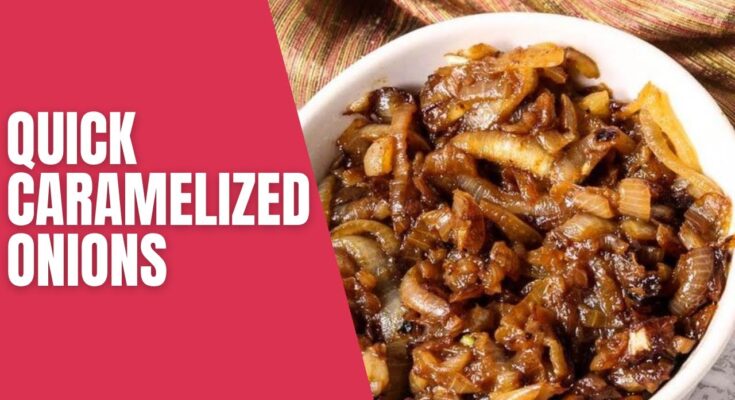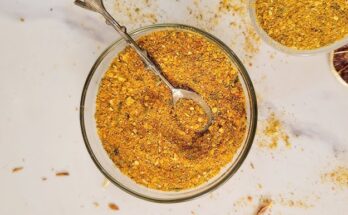Caramelized Onions Recipe: Caramelized onions are the unsung heroes of countless dishes. Their rich, sweet, and savory flavor can transform a simple meal into something extraordinary.
Whether you’re topping a burger, stirring them into pasta, or spreading them on pizza, caramelized onions add depth and complexity. The process may take some time, but trust me—it’s worth every minute.
Let’s dive into this guide to learn how to caramelize onions perfectly.
What Are Caramelized Onions?
Caramelized onions are onions that have been cooked slowly over low heat until their natural sugars break down and develop a deep golden-brown color. This slow cooking process creates a rich, sweet, and slightly tangy flavor.
Many people confuse caramelized onions with sautéed onions. The difference lies in the cooking time and method. Sautéed onions are cooked quickly over high heat, while caramelized onions take time, patience, and low heat to achieve that signature melt-in-your-mouth texture.
Ingredients Needed
The beauty of caramelized onions lies in their simplicity. You only need a few ingredients to get started:
- Onions: Yellow, white, or red onions work best
- Butter or Oil: For cooking and adding richness
- Salt: To enhance flavor
- Optional: Sugar (to speed up caramelization), balsamic vinegar, or herbs for added depth
Ingredient Insights:
The type of onion you choose can affect the final flavor. Yellow onions tend to caramelize the best due to their balanced sugar content, but red onions can add a slightly tangier taste if you’re feeling adventurous.
Equipment You Will Need
Before you start, gather the following tools:
- Cutting Board and Knife: For slicing the onions evenly
- Large Skillet or Pan: Use a wide, heavy-bottomed skillet for even heat distribution
- Spatula or Wooden Spoon: To stir the onions without damaging the pan
Pro Tip: A cast-iron skillet works wonders for caramelizing onions, as it retains heat evenly and can develop rich flavors over time.
Preparing the Onions
The way you prepare your onions can make or break the caramelization process. Here’s how to do it right:
- Choose the Right Onions: Yellow onions are the go-to option, but white and red onions can also work for a twist in flavor.
- Peel and Slice: Remove the skin, trim the ends, and slice the onions thinly. Aim for slices about 1/4 inch thick. Uniform slices ensure even cooking.
Tip: Avoid slicing the onions too thin, or they might burn before caramelizing.
How Long Does It Take to Caramelize Onions?
Caramelizing onions is a labor of love—it’s not a process you can rush. On average, it takes 30 to 45 minutes to achieve perfectly caramelized onions. However, if you’re using a lower heat or larger quantities, it can take up to an hour.
Factors that influence cooking time include:
- Onion variety
- Heat level (lower is better)
- Pan size and type
Shortcut Warning: While you may see recipes claiming to caramelize onions in 10 to 15 minutes, this often results in uneven browning or burnt onions. Patience is key!
Step-by-Step Instructions to Caramelize Onions
Step 1: Prepare Your Ingredients
Gather your onions, butter or oil, salt, and any optional ingredients like sugar or vinegar. Having everything ready ahead of time will make the process smoother.
Step 2: Heat the Pan and Add Oil or Butter
Place your skillet over medium-low heat and add a generous amount of butter, oil, or a combination of both. You want enough fat to coat the bottom of the pan, but not so much that the onions are swimming in it.
Step 3: Add and Stir the Onions
Once the butter has melted and the pan is heated, add the sliced onions. Stir them to coat evenly in the fat. You should hear a gentle sizzle, not a loud crackle—if it’s too hot, lower the heat immediately.
Step 4: Cook on Low Heat
Allow the onions to cook slowly. Keep the heat low to prevent burning. At this stage, the onions will release moisture and start to soften. Be patient; the transformation is just beginning.
Step 5: Stir Occasionally
Stir the onions every few minutes to ensure even browning. Scrape the bottom of the pan to prevent sticking. If the onions dry out too much, you can add a splash of water or broth.
Step 6: Deglaze the Pan (Optional)
For extra flavor, you can deglaze the pan by adding a splash of balsamic vinegar, wine, or broth. This loosens any caramelized bits stuck to the pan and adds a tangy kick.
Step 7: Finish and Serve
Once the onions have turned a deep, golden brown and are soft and jammy, they’re ready to serve. Remove them from the heat and season with salt to taste.
Common Mistakes to Avoid
- High Heat: This will cause the onions to brown too quickly or burn.
- Infrequent Stirring: Neglecting to stir can lead to uneven caramelization.
- Rushing the Process: Caramelization takes time—don’t rush it!
Tips and Tricks for Perfect Caramelization
Achieving perfectly caramelized onions every time can be tricky, but with these tips, you’ll be a pro in no time.
- Choose the Right Fat: Butter adds a rich flavor, while oil has a higher smoke point, preventing burning. Combining the two gives you the best of both worlds.
- Use the Right Heat: Keep the heat low to medium-low. High heat will scorch the onions before they have a chance to caramelize.
- Be Patient: It may be tempting to crank up the heat, but caramelization requires slow cooking. Give yourself plenty of time and resist the urge to rush.
- Add Liquid if Needed: If the onions dry out, add a tablespoon of water, broth, or even wine. This helps loosen stuck bits on the pan and enhances flavor.
- Season at the End: Salt draws out moisture, so it’s best to wait until the onions are nearly done to add it. This allows for proper caramelization without steaming.
Variations of Caramelized Onions
Once you’ve mastered the basic recipe, try experimenting with different variations to create unique flavors:
- Add Sugar: A teaspoon of sugar can speed up the caramelization process and intensify the sweetness.
- Balsamic Glazed Onions: Add a splash of balsamic vinegar near the end of cooking for a tangy, slightly sweet glaze.
- Wine or Broth: Deglaze the pan with red wine, white wine, or broth for a burst of flavor.
- Herbs and Spices: Toss in thyme, rosemary, or a pinch of cinnamon for a subtle aromatic twist.
These variations are great for adding extra depth to gourmet recipes, such as caramelized onion tartlets or French onion soup.
How to Use Caramelized Onions
Wondering how to make the most of your caramelized onions? Here are some tasty ideas:
- Burgers and Sandwiches: Elevate your burger or grilled cheese sandwich by adding a generous layer of caramelized onions.
- Pasta and Pizza: Caramelized onions pair beautifully with creamy pasta sauces or as a topping on gourmet pizzas.
- Salads: Add warmth and sweetness to your salads by tossing in caramelized onions. They complement goat cheese, nuts, and arugula perfectly.
- Soups and Stews: Incorporate caramelized onions into French onion soup or hearty beef stews to boost flavor.
- Appetizers: Spread them on crostini, serve them with a cheese platter, or mix them into dips for an impressive starter.
The versatility of caramelized onions means they can be used in nearly any dish that needs a little extra flavor magic.
How to Store and Reheat Caramelized Onions
If you have leftovers (or want to make a large batch), follow these storage and reheating tips to keep your onions tasting fresh:
Storage
- Refrigerator: Store caramelized onions in an airtight container for up to 5 days.
- Freezer: For longer storage, place them in a freezer-safe container or zip-top bag. They’ll keep for up to 3 months.
Tip: Portion the onions into small containers or ice cube trays for easy use in future meals.
Reheating
- Stovetop: Warm the onions in a skillet over low heat with a splash of water or broth to prevent drying.
- Microwave: Use a microwave-safe dish and heat in short intervals, stirring occasionally.
Proper storage and reheating ensure that your caramelized onions retain their rich flavor and soft texture.
Health Benefits of Onions
Besides their amazing taste, onions offer several health benefits, even when caramelized:
- Rich in Antioxidants: Onions contain quercetin, an antioxidant that may reduce inflammation and support heart health.
- Boosts Immune Health: The sulfur compounds in onions help support the immune system and may lower the risk of certain infections.
- Improves Digestion: Onions are a good source of fiber, which promotes healthy digestion and gut bacteria balance.
- Supports Bone Health: Onions have been linked to improved bone density due to their high content of nutrients like vitamin C and manganese.
While caramelizing does reduce some of the nutrients due to heat, the onions still retain many health benefits, making them a nutritious addition to your meals.
FAQs about Caramelized Onions Recipe
1. What type of onions are best for caramelizing?
For caramelizing, yellow onions are preferred due to their natural sweetness and robust flavor. Red onions can also be used for a milder option, and sweet onions like Vidalias offer a less pungent taste but may burn more easily due to higher sugar content.
2. How long does it take to caramelize onions?
The process typically takes about 45 minutes to an hour over low to medium heat. Rushing this process can lead to burnt onions rather than caramelized ones. Patience is key for achieving that perfect golden-brown color and deep flavor.
3. Do I need to add sugar to caramelize onions?
No, adding sugar is not necessary. Onions naturally contain sugar, which caramelizes as you cook them slowly. Adding extra sugar can lead to overly sweet onions and might cause them to burn.
4. What kind of pan is best for caramelizing onions?
A heavy-bottomed skillet or pan is ideal as it distributes the heat evenly, preventing hot spots that can cause the onions to burn. Cast iron and stainless steel are excellent choices.
5. Can I caramelize onions in advance?
Yes, caramelized onions can be made in advance and stored in the refrigerator for up to a week or frozen for up to three months. This can be a great time-saver when planning meals.
6. What fat should I use for caramelizing onions?
Butter offers great flavor, while oils like olive or vegetable are healthier options. You can also use a combination of oil and butter to benefit from both the flavor of butter and the higher smoke point of oil.
Conclusion
Caramelized onions are a simple yet transformative ingredient that can take your cooking to the next level. With patience, the right technique, and a little creativity, you can create onions that are sweet, savory, and incredibly versatile. Whether you’re making gourmet burgers, pasta, or hearty stews, caramelized onions will elevate your dishes with deep, rich flavor.
Now it’s your turn—grab some onions, fire up the stove, and give this recipe a try. Trust me, once you master it, you’ll never look at onions the same way again.



